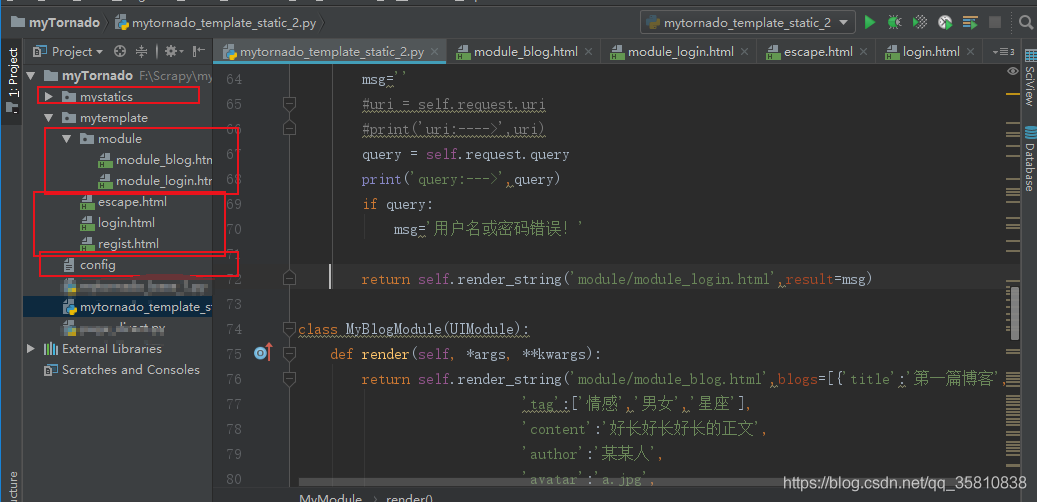property函数:在类中使用,将类中的方法伪装成一个属性
使用方法:在函数,方法,类的上面一行直接@装饰器的名字
装饰器的分类:
装饰器函数
装饰器方法:property
装饰类
class Student:def __init__(self,name):self.__name = name@propertydef name(self):return self.__name@name.setter #设置,修改(自我理解)def name(self,new_name): if type(new_name) is str: #只有当修改的值为str类型,才能被修改self.__name = new_name
a1 = Student("诸葛")
print(a1.name) #诸葛
a1.name = "睿智"
print(a1.name) #睿智
a1.name = 123
print(a1.name) #睿智
setter的用法:
setter是只有被property方法之后的,又实现了一个同名的方法,且被setter装饰器装饰了
它的作用是用来保护一个变量,在修改的时候能够添加一些保护条件。
deleter的用法:
一个方法被伪装成属性后,应该可以执行一个属性的增删改查操作,
所以deleter就是对应着被deleter装饰的方法,这个方法并不是只为了删除这个属性,而是你在代码中执行什么就有什么效果。
class Goods:__discount = 0.8def __init__(self,price):self.__price = price@propertydef price(self):return self.__price * self.__discount@price.setterdef price(self,new):if type(new) is int:self.__price = new@price.deleterdef price(self):del self.__price
apple = Goods(10)
print(apple.price) #8.0
print(apple.__dict__) #{'_Goods__price': 10}
apple.price = 20 #将__price的值进行修改
print(apple.price) #16
print(apple.__dict__) #{'_Goods__price': 20}
del apple.price #删除
print(apple.__dict__) #{}
deleter通常用在
class A:def __init__(self):self.__f = open('aaa','w')@propertydef f(self):return self.__f@f.deleterdef f(self):self.__f.close() #先关闭文件del self.__f #删除文件
@classmethod 将类中的方法变成类方法,为了不创建类对象,而直接用类方法修改静态私有属性。用法如下
只使用类中的资源,且这个资源可以直接用类名引用的使用,那这个方法在方法上面@classmethod将这个方法变成类方法
class Goods:__discount = 0.8 #静态私有属性def __init__(self,price):self.__price = price #私有对象属性self.name = "apple" #对象属性@propertydef price(self):return self.__price *Goods.__discount@classmethod #类方法def change_disount(cls,new): #cls 表示Goods这个类cls.__discount = new #对Goods中的静态私有属性进行修改
print(Goods.__dict__) # '_Goods__discount': 0.8,
Goods.change_disount(0.7)
print(Goods.__dict__) #'_Goods__discount': 0.7,
@staticmethod 静态方法 (如果函数要在类中使用,就用静态方法)
class Student:@staticmethod #在类中创建函数def login(usr,pwd):print('IN LOGIN',usr,pwd)Student.login('user','pwd')
总结
# 类:# 静态属性 类 所有的对象都统一拥有的属性# 类方法 类 如果这个方法涉及到操作静态属性、类方法、静态方法 cls 表示类# 静态方法 类 普通方法,不使用类中的命名空间也不使用对象的命名空间 : 一个普通的函数 没有默认参数# 方法 对象 self 表示对象# property方法 对象 slef 表示对象
isinstance(a,A) 判断对象与类直接的关系
issubclass(A,B) 判断类与类之间的关系
class A:pass
class B(A):pass
a = A()
b = B()
# print(type(a) is A) #True
# print(type(b) is B) #True
# print(type(b) is A) #False# print(isinstance(a,A)) #True #isinstance判断对象a与类A的关系(自我理解)
# print(isinstance(b,A)) #True
# print(isinstance(a,B)) #False
print(issubclass(B,A)) #True
print(issubclass(A,B)) #False 判断类与类之间的关系








 京公网安备 11010802041100号
京公网安备 11010802041100号